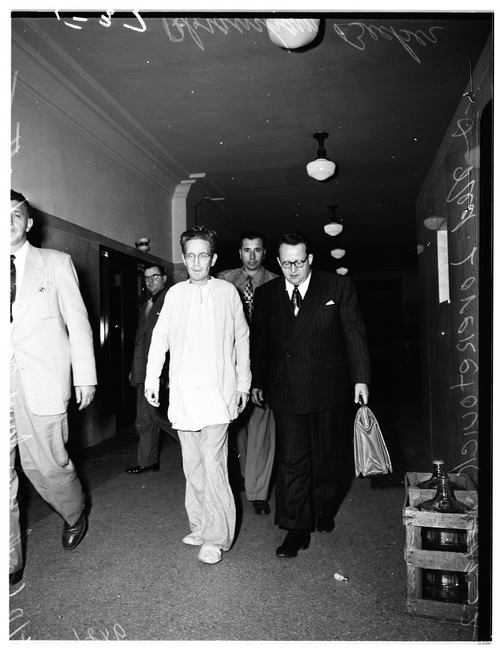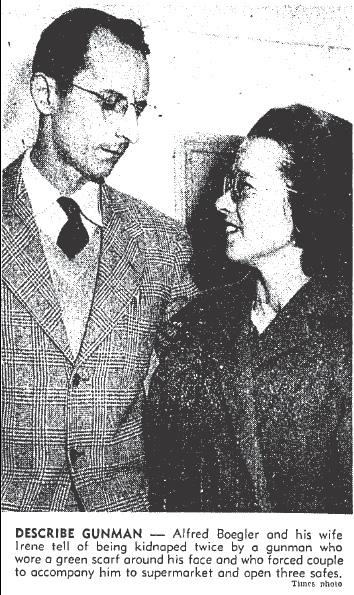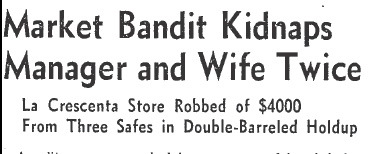Two weeks after Sheriff’s deputies shot James Monroe Rudolph, the Green Scarf Bandit, he was on the mend in the prison ward of General Hospital. Doctors said Rudolph was weak. Evidently, he was strong enough to confess to scores of robberies, burglaries, assaults, and kidnappings. Deputy District Attorney Howard Hurd and a couple of Sheriff’s deputies, including one of my favorites from the era, Detective Sergeant Ned Lovretovich, were on hand to witness the statements made by Monroe.

Deputies placed Rudolph in custody following a call from eight-year-old Jimmy Jones. While Rudolph kidnapped his parents at gunpoint, Jimmy feigned sleep. As soon as it was safe, he called the sheriff’s department. Jimmy’s call resulted in the capture of the Green Scarf Bandit. For his courage, Sheriff Eugene Biscailuz had awarded the boy a miniature Sheriff’s badge.
The authorities were keen to get Rudolph in front of a judge, but his physical condition delayed the proceedings. Another complication was there was so much stolen loot in the Rudolph home in Placerville that it would take time for it to be sorted out, put on trucks, and placed into evidence. Cops estimated the worth of the stolen goods to be about $60,000 [$537,851.00 in current U.S. dollars].
On January 30th, James Monroe Rudolph, clad in his prison ward jammies, sufficiently healed from his multiple gunshot wounds, appeared for arraignment before Municipal Judge F. Ray Rennett.
In the complaint, sworn to by Deputy Sheriff Dave Terry, and issued by the Deputy D.A., Rudolph found himself charged with five counts of robbery, four of attempted robbery, nine of kidnapping and two of false imprisonment. Four of the robberies involved food markets from which Rudolph had stolen thousands of dollars in cash.
One robbery was especially audacious. Just a few days prior to the kidnapping of B.G. Jones and his wife, the Green Scarf Bandit used the same M.O. to rob a La Crescenta supermarket manager and his wife twice in one day!
Alfred W. Boegler and his wife Irene awakened by a soft noise at about midnight, saw a man in a green scarf mask climb through their bedroom window. Holding a pistol to the couple, the bandit politely turned his head as Irene changed from her nightgown into street clothes so she could accompany her husband and the crook to the Shopping Bag Market at 3100 Foothill Blvd in La Crescenta.

Alfred related to investigators a conversation he had with the masked intruder. “When we asked him what was to be done about our two sleeping children, he said that it was too cold to take children outdoors–and that they might get injured if there was a night watchman who started any shooting. He said if we co-operated on driving him to the store and opening the safe, we would be safely back home within 30 minutes.”
He may have been a gun wielding thug, but he wasn’t indifferent to the comfort and safety of young children. As the couple’s two daughters, Barbara (4) and Karen (18 months) slept, Boegler drove his wife and the robber to the market. Once they arrived at the store, the gunman used Irene as a hostage while Alfred went into the store with a passkey and turned off the burglar alarm. All the while, the gunman apologized, saying that his boss was “pretty tough” and he’d face dire consequences if the job didn’t go off perfectly.
After looting two safes at the market, the bandit let the Boeglers out of their car at the corner of Altura Street and Pennsylvania Avenue. They phoned the Montrose Sheriff’s station (the same station young Jimmy Jones called a few days later) and walked the short distance to their home. They collected their two kids and went to the home of Boegler’s brother, William.

When the Boeglers returned to their own home, a mere six hours after being taken from their warm bed, they were met by the green scarfed gunman who was waiting patiently for them in the kitchen.
“You double-crossed me. My boss doesn’t like that. We missed one safe.”
The man then kidnapped the Boeglers for a second time, emptied a third safe, and fled.
Rudolph may have thought of himself only as a bandit, but two of the kidnapping charges involved bodily harm, which in California, because of the Little Lindbergh Law, could send him to the gas chamber.

Following the kidnapping and murder of Charles Lindbergh, Jr. on March 1, 1932, Congress adopted the Federal Kidnapping Act (aka Lindbergh Law), a law which allowed the feds to step in once kidnappers had crossed state lines with their victim. There were several states, California among them, that implemented their own versions of the law which applied in cases of kidnapping when victims were not transported across state lines; hence Little Lindbergh. California’s Little Lindbergh statute made kidnapping with bodily harm a crime eligible for the death penalty.
In 1951, when the Green Scarf Bandit was busted, the Red-Light Bandit (Caryl Chessman) was already on California’s death row for kidnapping—convicted under the Little Lindbergh law. Knowing that another bandit was sitting on death row may have provided the motivation for Rudolph to plead guilty to three felony charges: armed robbery, kidnapping for purpose of robbery, and false imprisonment. With his plea, Rudolph evaded the death penalty. For his misdeeds, they sentenced him to a term of five years to life.
The Green Scarf Bandit had no intention of serving his full sentence. About seven months after arriving at Folsom Prison, Rudolph, and his cell mate, Claude Newton, tried to break out.
They used an age-old method to fool the guards. They stuffed their overalls with paper and placed decoys in their bunks. Newton even braided a rope out of bed sheets and put a hook on the end so they could scale the wall. As they waited for the right moment to flee, the guards found them.
Warden Robert A. Heinze had the last word on the attempted escape.
“Everything was set to go on the escape, but it didn’t work.”

